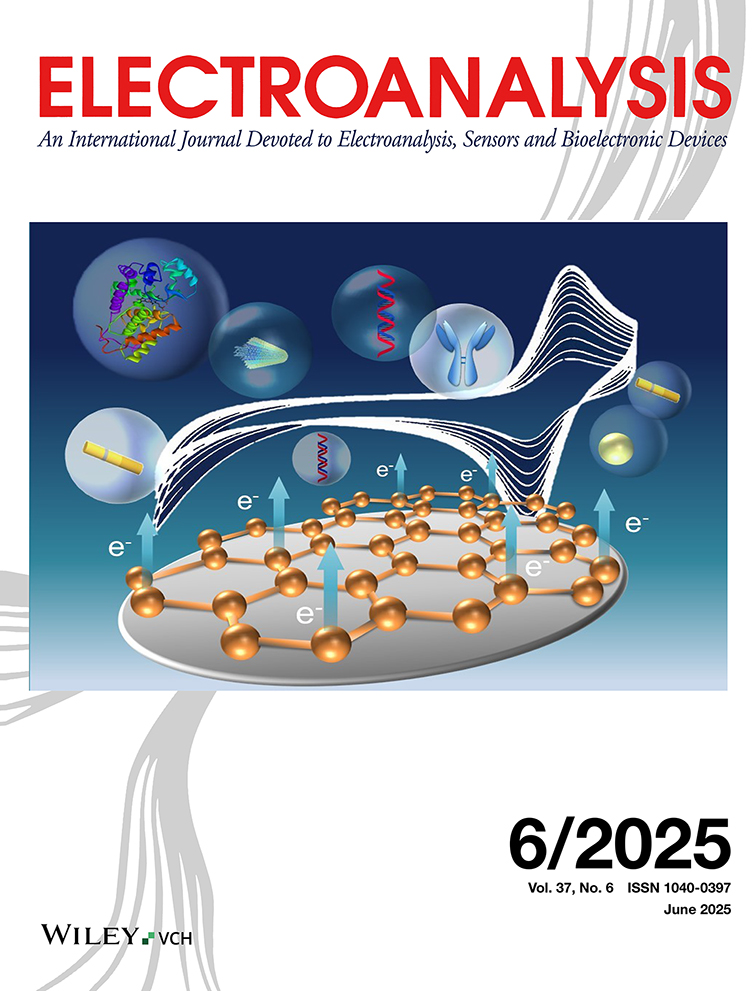Inlaid Multi-Walled Carbon Nanotube Nanoelectrode Arrays for Electroanalysis
Jun Li
Center for Nanotechnology, NASA Ames Research Center, Moffett Field, CA 94035
Search for more papers by this authorJessica E. Koehne
Center for Nanotechnology, NASA Ames Research Center, Moffett Field, CA 94035
Search for more papers by this authorAlan M. Cassell
Center for Nanotechnology, NASA Ames Research Center, Moffett Field, CA 94035
Search for more papers by this authorHua Chen
Center for Nanotechnology, NASA Ames Research Center, Moffett Field, CA 94035
Search for more papers by this authorHou Tee Ng
Center for Nanotechnology, NASA Ames Research Center, Moffett Field, CA 94035
Search for more papers by this authorQi Ye
Center for Nanotechnology, NASA Ames Research Center, Moffett Field, CA 94035
Search for more papers by this authorWendy Fan
Center for Nanotechnology, NASA Ames Research Center, Moffett Field, CA 94035
Search for more papers by this authorJie Han
Center for Nanotechnology, NASA Ames Research Center, Moffett Field, CA 94035
Search for more papers by this authorM. Meyyappan
Center for Nanotechnology, NASA Ames Research Center, Moffett Field, CA 94035
Search for more papers by this authorJun Li
Center for Nanotechnology, NASA Ames Research Center, Moffett Field, CA 94035
Search for more papers by this authorJessica E. Koehne
Center for Nanotechnology, NASA Ames Research Center, Moffett Field, CA 94035
Search for more papers by this authorAlan M. Cassell
Center for Nanotechnology, NASA Ames Research Center, Moffett Field, CA 94035
Search for more papers by this authorHua Chen
Center for Nanotechnology, NASA Ames Research Center, Moffett Field, CA 94035
Search for more papers by this authorHou Tee Ng
Center for Nanotechnology, NASA Ames Research Center, Moffett Field, CA 94035
Search for more papers by this authorQi Ye
Center for Nanotechnology, NASA Ames Research Center, Moffett Field, CA 94035
Search for more papers by this authorWendy Fan
Center for Nanotechnology, NASA Ames Research Center, Moffett Field, CA 94035
Search for more papers by this authorJie Han
Center for Nanotechnology, NASA Ames Research Center, Moffett Field, CA 94035
Search for more papers by this authorM. Meyyappan
Center for Nanotechnology, NASA Ames Research Center, Moffett Field, CA 94035
Search for more papers by this authorAbstract
The rapid development in nanomaterials and nanotechnologies has provided many new opportunities for electroanalysis. We review our recent results on the fabrication and electroanalytical applications of nanoelectrode arrays based on vertically aligned multi-walled carbon nanotubes (MWCNTs). A bottom-up approach is demonstrated, which is compatible with Si microfabrication processes. MWCNTs are encapsulated in SiO2 matrix leaving only the very end exposed to form inlaid nanoelectrode arrays. The electrical and electrochemical properties have been characterized, showing well-defined quasireversible nanoelectrode behavior. Ultrasensitive detection of small redox molecules in bulk solutions as well as immobilized at the MWCNT ends is demonstrated. A label-free affinity-based DNA sensor has shown extremely high sensitivity approaching that of fluorescence techniques. This platform can be integrated with microelectronics and microfluidics for fully automated microchips.
References
- 1 R. M. Wightman, Anal. Chem. 1981, 53, 1125A.
- 2 Ultramicroelectrodes (Eds: ), Datatech Systems, Morganton, NC 1987.
- 3 R. B. Morris, D. J. Franta, H. S. White, J. Phys. Chem. 1987, 91, 3559.
- 4 R. M. Penner, M. J. Heben, T. L. Longin, N. S. Lewis, Science 1990, 250, 1118.
- 5 F.-R. F. Fan, A. J. Bard, Science 1995, 267, 871.
- 6 S. Chen, A. Kucernak, J. Phys. Chem. 2002, 106, 9396.
- 7 J. L. Conyers, H. S. White, Anal. Chem. 2000, 72, 4441.
- 8 C. Demaille, M. Brust, M. Tsionsky, A. J. Bard, Anal. Chem. 1997, 69, 2323.
- 9 V. P. Menon, C. R. Martin, Anal. Chem. 1995, 67, 1920.
- 10 R. M. Penner, C. R. Martin, Anal. Chem. 1987, 59, 2625.
- 11 W. S. Baker, R. M. Crooks, J. Phys. Chem. B 1998, 102, 10041.
- 12 E. Katz, I. Willner, J. Wang, Electroanalysis 2004, 16, 19.
- 13 R. C. McGlennen, Clin. Chem. 2001, 47, 393.
- 14 M. Han, X. Gao, J. Z. Su, S. Nie, Nat. Biotechnol. 2001, 19, 631.
- 15 W. Fritzsche, T. A. Taton, Nanotechnology 2003, 14, R63.
- 16 B. S. Sherigara, W. Kutner, F. D'Souza, Electroanalysis 2003, 15, 753.
- 17 L. Dai, P. He, S. Li, Nanotechnology 2003, 14, 1081.
- 18 J. J. Gooding, R. Wibowo, J. Liu, W. Yang, D. Losic, S. Orbons, F. J. Mearns, J. G. Shapter, D. B. Hibbert, J. Am. Chem. Soc. 2003, 125, 9006.
- 19 J. Wang, M. Musameh, Y. Lin, J. Am. Chem. Soc. 2003, 125, 2408.
- 20 X. Yu, D. Chattopadhyay, I. Galeska, F. Papadimitrakopoulos, J. F. Rusling, Electrochem. Commun. 2003, 5, 408.
- 21 R. J. Chen, S. Bangsaruntip, K. A. Drouvalakis, N. W. S. Kam, M. Shim, Y. Li, W. Kim, P. J. Utz, H. Dai, Proc. Natl. Acad. Sci. USA 2003, 100, 4984.
- 22 J. Li, H. T. Ng, A. Cassell, W. Fan, H. Chen, Q. Ye, J. Koehne, J. Han, M. Meyyappan, Nano Lett. 2003, 3, 597.
- 23 J. Koehne, H. Chen, J. Li, A. M. Cassell, Q. Ye, H. T. Ng, J. Han and M. Meyyappan, Nanotechnology 2003, 14, 1239.
- 24 J. Koehne, J. Li, A. M. Cassell, H. Chen, Q. Ye, H. T. Ng, J. Han, M. Meyyappan, J.Mat. Chem. 2004, 14, 676.
- 25 J. Koehne, J. Li, A. M. Cassell, H. Chen, Q. Ye, J. Han, M. Meyyappan, MCB 2004, 1, 69.
- 26 J. Koehne, H. Chen, A. M. Cassell, Q. Ye, J. Han, M. Meyyappan, J. Li, Clin. Chem. 2004, 50, 1886.
- 27 M. S. Dresselhaus, G. Dresselhaus, P. C. Eklund, Science of Fullerenes and Carbon Nanotubes. Academic Press, New York 1996.
- 28 T. W. Ebbessen, Carbon Nanotubes: Preparation and Properties, CRC Press, Boca Raton, FL 1997.
- 29 R. Saito, M. S. Dresselhaus, G. Dresselhaus, G. Physical Properties of Carbon Nanotubes, World Scientific, New York 1998.
- 30 D. Tománek, R. Enbody, Science and Application of Nanotubes, Kluwer Academic, New York, 2000.
- 31 S. Iijima, T. Ichihashi, Nature 1993, 363, 603.
- 32 S. Iijima, Nature 1991, 354, 56.
- 33 H. Dai, Acc. Chem. Res. 2002, 35, 1035.
- 34 P. G. Collins, M. S. Arnold, P. Avouris, Science 2001, 292, 706.
- 35 L. McCreery, in Electroanalytical Chemistry ( ), Marcel Dekker, New York 1991, 17,.221–374.
- 36 Z. F. Ren, Z. P. Huang, J. W. Xu, J. H. Wang, P. Bush, M. P. Siegal, P. N. Provencio, Science 1998, 282, 1105.
- 37 B. A. Cruden, A. M. Cassell, Q. Ye, M. Meyyappan, J. Appl. Phys. 2003, 94, 4070.
- 38 A. M. Cassell, Q. Ye, B. A. Cruden, J. Li, P. C. Sarrazin, H. T. Ng, J. Han, M. Meyyappan, Nanotechnology 2004; 15, 9.
- 39 V. I. Merkulov, A. V. Melechko, M. A. Guillorn, D. H. Lowndes, M. L. Simpson, Appl. Phys. Lett. 2002, 80, 476.
- 40 J. Li, R. Stevens, L. Delzeit, H. T. Ng, A. Cassell, J. Han, M. Meyyappan, Appl. Phys. Lett. 2002, 81, 910.
- 41 J. Li, Q. L. Ye, A. M. Cassell, H. T. Ng, R. Stevens, J. Han, M. Meyyappan, Appl. Phys. Lett. 2003, 82, 2491.
- 42 G. T. Hermanson, Bioconjugate Techniques, Academic Press: New York 1996; p. 178.
- 43 A. J. Bard, L. R. Faulkner, Electrochemical Methods: Fundamentals and Applications, 2nd ed., Wiley: New York 2001, pp 216–218.
- 44 J. R. Macdonald, Impedance Spectroscopy, Wiley, New York 1987.
- 45 H. Kato, H. Sakai, K. Sugawara, J. Electrochem. Soc. 1994, 141, 3154.
- 46 W. H. Mulder, J. H. Slutyes, T. Pajkossy, I. Nyikos, J. Electroanal. Chem. 1990, 285, 103.
- 47 C. H. Kim, S. I. Pyun, J. H. Kim, Electrochim. Acta 2003, 48, 3455.
- 48 E. Boubour, R. B. Lennox, J. Phys. Chem. B 2000, 104, 9004.
- 49 R. P. Janek, W. R. Fawcett, A. Ulman, Langmuir 1998, 14, 3011.
- 50 H. O. Finklea, D. A. Snider, J. Fedyk, E. Sabatani, Y. Gafni, I. Rubinstein, Langmuir 1993, 9, 3660.
- 51 D. A. Skoog, Principles of Instrumental Analysis, 3rd ed., CBS College Publishing, 1985.
- 52 P. Ugo, L. M. Moretto, S. Bellomi, V. P. Menon, C. R. Martin, Anal. Chem. 1996, 68, 4160.
- 53 Y. Lin, F. Lu, Y. Tu, Z. Ren, Nano. Lett. 2004, 4, 191.
- 54 Y. Miki, J. Swensen, D. Shattuck-Eidens, P. A. Futreal, K. Harshman, S. Tavtigian, Q. Liu, C. Cochran, L. M. Bennett, W. Ding, Science 1994, 266, 66.
- 55 M. F. Sistare, R. C. Holmberg, H. H. Thorp, J. Phys. Chem. B 1999, 103, 10718.
- 56 P. M. Armistead, H. H. Thorp, Anal. Chem. 2000, 72, 3764.
- 57 N. D. Popovich, H. H. Thorp, Interface 2002, 11, 30.
- 58 S. Sotiropoulou, N. A. Chaniotakis, Anal. Bioanal. Chem. 2003, 375, 103.
- 59 T. E. McKnight, A. V. Melechko, G. D. Griffin, M. A. Guillorn, V. I. Merkulov, F. Serna, D. K. Hensley, M. J. Doktycz, D. H. Lowndes, M. L. Simpson, Nanotechnology 2003, 14, 551.
- 60 Y. Cui, Q. Wei, H. Park, C. M. Lieber, Science 2001, 293, 1289.
- 61 J. V. Staros, Biochemistry 1982, 21, 3950.
- 62 E. Ostuni, R. G. Chapman, R. E. Holmlin, S. Takayama, G. M. Whitesides, Langmuir 2001, 17, 5605.
- 63 Z. F. Ren, Z. P. Huang, D. Z. Wang, J. G. Wen, J. W. Xu, J. H. Wang, L. E. Calvet, J. Chen, J. F. Klemic, M. A. Reed, Appl. Phys. Lett. 1999, 75, 1086.





